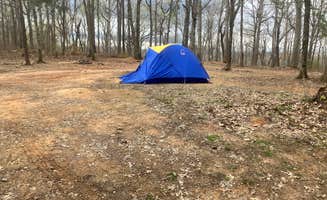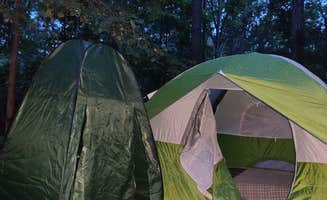Dispersed camping near Southmont, North Carolina offers backcountry opportunities within Uwharrie National Forest, a hardwood forest ecosystem with elevations ranging from 300 to 700 feet. The region features moderate hiking trails connecting creeks and waterways, particularly along the 20-mile Uwharrie Trail that runs north-south through the forest. Weather patterns create distinct seasonal camping conditions with hot, humid summers and mild winters.
What to do
Creek exploration: Multiple waterways throughout Uwharrie National Forest provide opportunities for paddling and fishing. According to one camper at Uwharrie National Forest, "Me and my friends would always float our kayaks down the river to a place we called 'Bird Dog' and camp for the night. If you are looking for a place that has very little traffic, this is the place you want to go!"
OHV trail riding: The forest contains designated off-highway vehicle routes requiring permits available at local outposts. A visitor notes, "We took our Jeep on the OHV trails and had a blast. There are several places you can take a canoe or kayak on and the scenery on the lake was beautiful as well."
Multi-day backpacking: The complete Uwharrie Trail spans approximately 20 miles and offers multiple camping spots. "The streams, provided one has filtration or iodine tablets, provide ample sources of drinking water," mentions one backpacker at Uwharrie National Forest. The trail allows for 2-3 day treks with multiple established campsites along the route.
What campers like
Seclusion: Many dispersed sites provide privacy away from developed areas. One camper at Dispersed Camping off Falls Dam Trail shared, "Had a good time camping and enjoyed the song of wind and birds."
Water proximity: Several primitive sites are positioned near creeks and streams. A camper notes, "Along the Uwharrie trail. Water available on both sides of camp / trail." This provides both practical water access and scenic camping locations.
Trail connectivity: The network of hiking paths allows campers to establish basecamp and explore different routes. At Birkhead Mountain Wilderness Area Dispersed, a visitor commented, "Very nice trails. Well maintained. Not marked the best... signs at intersections. Plenty of creeks. Hike in for dispersed camping."
What you should know
Hunting awareness: Uwharrie is an active hunting area during designated seasons. "Make sure to wear bright colors during hunting season because there are a ton of people out deer hunting in this area," advises one experienced camper.
Vehicle requirements: Many dispersed sites require appropriate vehicles. A regular visitor states, "This is a great area for dispersed campers with 4WD or AWD. It's pretty popular so head out early to secure your spot. Some of the sites may have a little trash left from the last user, so please try to leave it cleaner than you came to."
Trail navigation challenges: Some trail sections lack clear markings or may flood. One backpacker explains, "The trailhead is kind of hard to follow sometimes, sections of the trail are prone to flooding and creek crossings can become difficult following heavy rains."
Tips for camping with families
Start with shorter hikes: For families with young children, the moderate trails near Robbins Branch Trail provide accessible camping options without extensive hiking requirements.
Consider shared sites: One camper recommends, "The tent sites nice and clean and level. The host drove through many many times in the 3 days I was there." This regular patrol adds security for family groups.
Multi-activity options: Families can combine camping with varied recreation. "The State Forest has camping. We used our pop-up with a generator in rustic locations. There are hiking, horse, OHV, dirt bike, ATV, and mountain bike trails," notes one visitor describing the diverse activities available.
Tips from RVers
Limited true RV options: Most dispersed sites don't accommodate larger vehicles. One RVer states, "This is not an RV camping area, at least not the dispersed camping area. You cannot drive up to the campsites. There are no electric, water, or sewer hookups."
Pop-up alternatives: Smaller, more maneuverable campers work better for forest roads. A camper shares, "We stayed in 2 different dispersed primitive sites and they were both great. Plenty of space and trees and privacy!"
Preparation requirements: Self-sufficiency is essential in dispersed locations. "It was definitely a long drive but we will definitely be making the trip again. We really liked the secluded primitive campsites and the various trails we were able to take our Jeep on," reports one visitor who found the preparation worthwhile.



